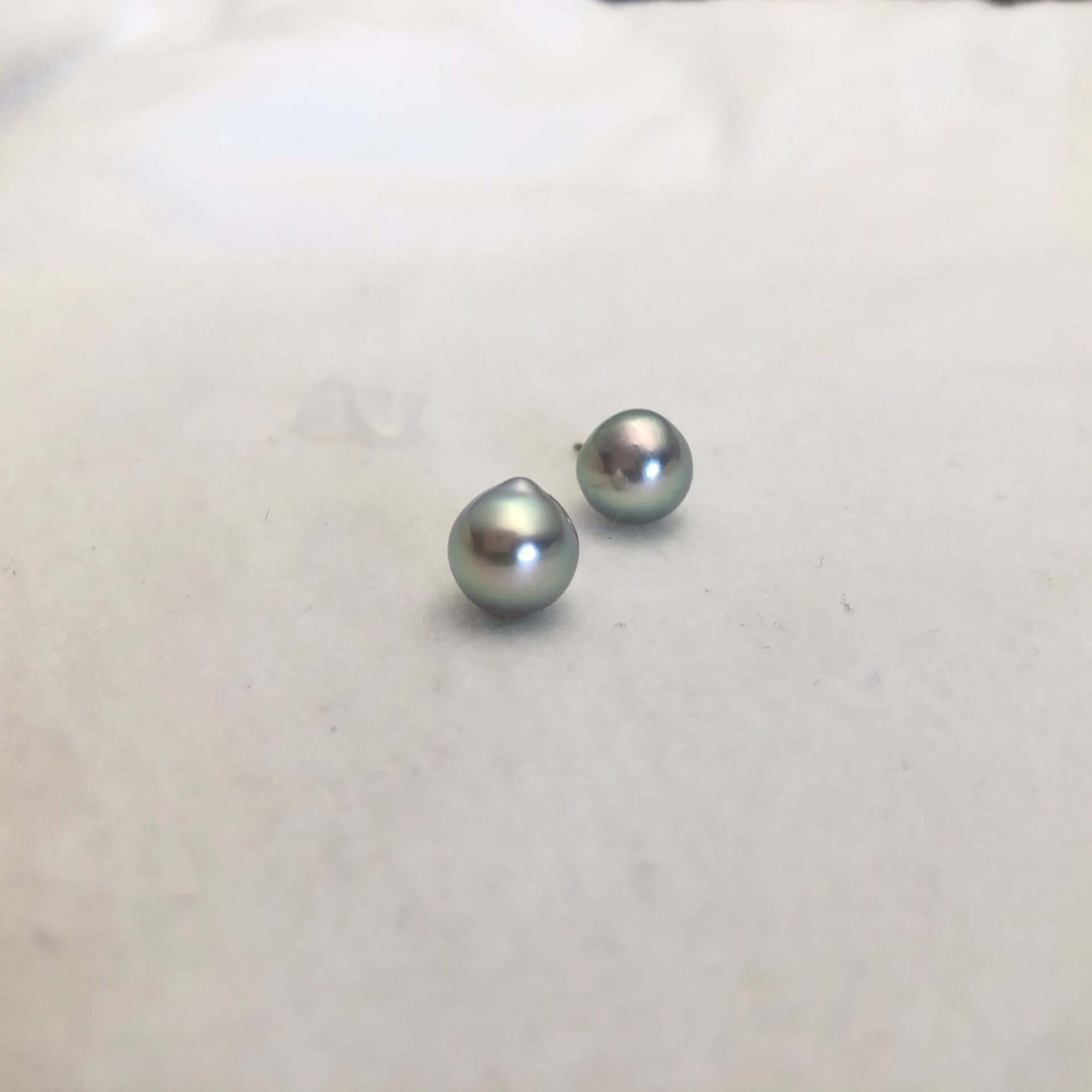H. Akoya 8.32-8.23mm earrings, seawater pearl, natural blue color, not dyed, pt900, from Japan. H


Akoya earrings
$228.37
1 in stock
These are Akoya pearl stud earrings. One of the pearls has dimples on its side, resembling small indentations or wounds. The surface is not perfectly smooth. However, its transparency and luster are captivating. The pearl seems as if it’s covered with a transparent glass layer. This characteristic is partly due to the 40-day cultivation method used just before harvest.
Pearl farmers strive to produce pearls with the best possible surface just before harvest. Specifically, they achieve this by leaving the Akoya oysters undisturbed.
Akoya oysters are cleaned once every two weeks to a month. This cleaning involves a high-pressure water jet shower, which removes barnacles, scallops, and parasites from the oyster’s surface. This strong stimulus is said to encourage the Akoya oysters to secrete more layers of pearl nacre.
In the past (30 to 40 years ago), the approach was to thoroughly spray high-pressure water on the Akoya oysters with the attitude of “Don’t care if the oysters die; the ones that survive will produce good pearls!” At that time, the Akoya oysters responded by producing pearls with quite thick nacre layers.
However, recent Akoya oysters cannot withstand high-pressure showers, as they tend to die if the pressure is too strong.
In Japan, corporate culture used to involve very harsh and high-pressure guidance from superiors to subordinates. Forced overtime, mandatory company parties, and severe reprimands from bosses were the norm. Subordinates had to cling desperately to the company and their superiors. This was likely during the era when Japan was considered “Number One.”
I haven’t experienced this myself, but it was the reality for many back then.
This is the process of making these earrings.
Today, in 2024, such high-pressure guidance is considered illegal and morally unacceptable. Superiors who employ high-pressure or violent methods risk having their subordinates resign or become ill.
It’s often said among pearl farmers that the situation with Akoya oysters resembles these changing attitudes towards management.
Akoya oysters regularly experience such “cleaning” sessions. However, as harvest time approaches, these cleanings are suspended. The skill of a pearl farmer is shown in how long they can delay cleaning before harvest. The length of this pause affects the quality of the pearl layers the oysters secrete.
During winter, Akoya oysters are less active and secrete fewer nacre layers. An oyster that had its nucleus inserted in December may barely form any nacre layers by March. The oysters essentially “sleep” through the winter.
Pearl farmers use the oysters’ physiological state before harvest to their advantage. By keeping the oysters in a calm state, they encourage the formation of delicate nacre layers just before harvest. This process is called “Ke-Syou-Maki” (Ke-Syou meaning “makeup” and Maki meaning “forming nacre layers”).
This is the process of making these earrings.
If the outer layer of a pearl is perfectly smooth, it signifies good management of the Akoya oysters by the pearl farmers.
Of course, pearls are created by the living Akoya oysters and the natural environment of the sea. Even with human management, it might only account for about 20% of the outcome. Pearl farmers themselves acknowledge that complete control over living organisms and nature is impossible.
I appreciate pearl farmers who have a humble attitude towards nature.
Interestingly, the introduction of the “makeup” process before harvest also faced many difficulties. Although this method has been around for about 30 years, only a few pearl farmers have adopted it. There were employees who wanted to implement this process, but their superiors insisted on “stimulating the oysters to the point of death to secrete nacre!” New methods are rarely adopted immediately.
This is the process of making these earrings.
The similarities between the world of Akoya oysters and human experiences are fascinating.
In the past, superiors would rigorously train and educate their subordinates. Nowadays, superiors are expected to be much gentler with their staff.
These stories are general observations and may not apply to specific cases, as individual circumstances vary. What is right or wrong is not always clear to me.
However, I find it intriguing that the world of Akoya oysters mirrors the world of humans so closely. Personally, I prefer being treated gently rather than harshly.
If I were an Akoya oyster, I would probably eject the pearl and retire if subjected to high-pressure showers. Sometimes, I find myself seeing Akoya oysters as reflections of human experiences.
Even if an Akoya oyster follows instructions perfectly, it might still produce a low-quality pearl. Conversely, an oyster that doesn’t follow instructions might produce a top-quality pearl.
The effectiveness of the “makeup” process can vary from one oyster to another. Overall, it is effective, but some oysters are unaffected.
There are instances where, despite efforts, the outcome doesn’t match expectations. Questions about fate and whether “God exists” often arise.
This is the process of making these earrings.
In the world of pearls, “roundness” is often considered the ideal. Baroque pearls can’t compete with round pearls in this respect. Round pearls, even if they have thin nacre and weak luster, are valued more highly than baroque pearls with thick nacre and strong luster.
These two lines alone almost bring me to tears. It’s clear that effort alone doesn’t always lead to recognition if the direction is wrong.
I wish that quality and shape could be evaluated separately. I want to showcase baroque pearls as high-quality pearls in environments where they can be appreciated, which is likely for my own sake.
I hope this lengthy explanation conveys what I wanted to express.
Thank you for reading through it all.
Here is a video comparing these H earrings with other earrings that were produced together.